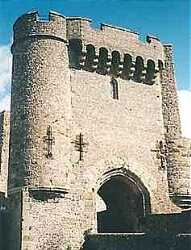De Warrenne Family
When William the Conqueror returned to Normandy in 1067, he made grants of land, including the town of Lewes, to one of his lords, William de Warrenne. Within a few years Warrenne had built an unusual motte and ailey stronghold here, surrounded by defensive earthworks and a moat. Lewes Castle became his main residence, although he did build two other castles, one in Surrey and one in Norfolk. In 1075 the King appointed Warenne joint Chief Justiciar, and soon after that he became the first Earl of Surrey. The remains of William de Warenne and his wife Gundrada, plus original tomb furnishings, can now be found in the Gundrada Chapel at Southover Church.
Following the defeat of Llywelyn ap Gruffydd, the last independent Prince of Wales in 1282, Edward I
gave John de Warenne, Earl of Surrey, the lordship of Bromfield and Yale. To secure his newly gained lands,
John built Holt Castle, also known as Lion's Castle, to control a nearby strategic ford across the River
Dee. John de Warenne's successor, also John, was leader of the English forces in Scotland. In 1296 he
defeated the Red Comyn and the Scottish forces at the Battle of Dunbar and deposed the Scottish King John
Balliol. Edward I made de Warenne Regent of Scotland. It was a job that only brought him trouble. William
Wallace led a revolt and defeated de Warenne and the English at the Battle of Stirling Bridge on September
11th 1296. De Warenne was forced to flee the field of battle and make his excuses to Edward I "Longshanks". ....
more

The entrace gate to the Castle of Lewes, originally built by William de Warrenne
- A1 = Ranulph I de Warrenne, d:1074, m. Beatrice de Vascoeuil;
- B1 = Ranulph II de Warrenne;
- C1 = William I de Warrenne, Earl of Surrey, d: 1088, m. Gundred of Normandy;
==> Normans
- D1 = William II de Warrenne, Earl of Warren and Surrey, d:1138, m. Isabel de Vermandois;
==> Capet Dynasty
- E1 = Adelicia de Warrenne, m. Sir Henry, Earl of Huntingdon; <== House of Dunkeld
- E2 ~ Sir William III de Warrenne, Earl of Warren and Surrey, lvd:1118/1148, m. Ela Talvas;
<== Clan Montgomery
- F1 ~ Isabel de Warrenne, Countess of Surrey, lvd:11137/1199, m. Hamelin Plantagenet; <== Plantagenet Dynasty
- D1 = William II de Warrenne, Earl of Warren and Surrey, d:1138, m. Isabel de Vermandois;
==> Capet Dynasty
- C1 = William I de Warrenne, Earl of Surrey, d: 1088, m. Gundred of Normandy;
==> Normans
- B1 = Ranulph II de Warrenne;